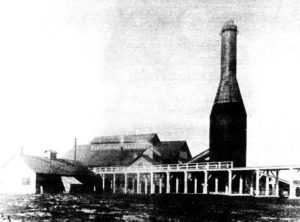Pioneering lumber baron Dodge went from riches to ruin in Georgian Bay
By John Merritt
Simcoe County Historical Association
Special to MuskokaTODAY.com
Anson Greene Phelps Dodge was the founder of the Georgian Bay Lumber Company, which operated sawmills along southern Georgian Bay from 1870 into the 1920s.

Photo courtesy the Huron Museum
He was known as Alphabet Dodge because he signed his name with all three of his first initials.
Dodge was born in 1834, in New York City, the son of mining magnate William Earl Dodge.
Anson and his six brothers received a liberal education at their father’s expense and were given all the money they needed to start their careers, which their father usually picked out for them.
But unlike his brothers, Anson wanted to follow his own course. After graduating from school he travelled the world and worked in sales and then mining, before settling on the lumber business, founding his own company, Dodge and Co., in Pennsylvania in 1864.
An impeccable dresser, Dodge had boundless energy and insatiable ambition and aspired to become the largest lumber producer in North America.
Dodge began lumber operations in Canada in 1866, purchasing newly available timber lands in the Parry Sound and Muskoka districts at the recommendation of Henry Sage, a fellow American lumberman already operating in Canada at a mill in Bell Ewart.
Between 1869 and 1871, Dodge bought or built eight of the nine sawmills then operating on southern Georgian Bay, including at Port Severn, Waubaushene, Sturgeon Bay, and Collingwood, and quickly acquired all the equipment needed to run a massive lumber business.
He built homes, stores, and even churches for his employees, and acquired hundreds of square miles of timber lands across North Simcoe.
In 1871 his Simcoe County holdings were incorporated as the Georgian Bay Lumber Company.

Dodge built a magnificent mansion for himself at Roche’s Point, a three-storey, 25-room stucco house dubbed “Beechcroft.” The grounds were designed by Frederick Olmstead, the landscape architect who had designed New York’s Central Park.
After first arriving in Canada, it did not take Dodge long to realize that if he hoped to succeed in business in Canada he would have to become involved in Canadian politics. He joined the federal Conservative Party (if only for the reason that the Conservatives were in power at the time) and befriended several leading Conservatives, almost all of whom were also Canadian railway magnates.
These friends all received shares in Dodge’s company in exchange for occasional assistance securing licenses and land rights for his business.
Dodge was pickked to run for York North in the 1872 federal election and to that end special legislation was passed naturalizing him as a British subject so that he would be eligible to take office.
Dodge won the election, but it was not long before the Toronto Globe published allegations that Dodge had faked a character reference during the campaign.
The scandal dominated every newspaper in the country until it was overshadowed a few weeks later by the Pacific Railway scandal that eventually brought down John A. Macdonald’s Conservative government..
Despite the controversy, within a few years Dodge had become one of the most powerful lumber barons in Ontario. But his success was short lived.
It soon became apparent that Dodge’s company was not earning nearly enough to pay off the large debts he had incurred when buying and equipping all his Georgian Bay mills.
Additionally, Dodge and his managers all had large salaries and extravagant expense accounts.
When prices and demand for Canadian lumber plummeted in the depression of 1873, Dodge found himself in serious financial trouble. Bankruptcy proceedings began against him in 1873 and he was forced to give up his company and his mansion and return Stateside, where he managed his father’s lumber interests in Georgia.
After his father died in 1883, Dodge settled in Danville, Illinois, where he lived happily off of a $250,000 inheritance. He died in obscurity in 1918.
The Simcoe County Historical Association is a voluntary non-profit organization dedicated to the promotion, preservation, and appreciation of the history and heritage of Simcoe County. For more information, please visit www.simcoecountyhistory.ca.

May 22, 2022 @ 7:38 pm
I have the logging stamp from William Earl Dodge